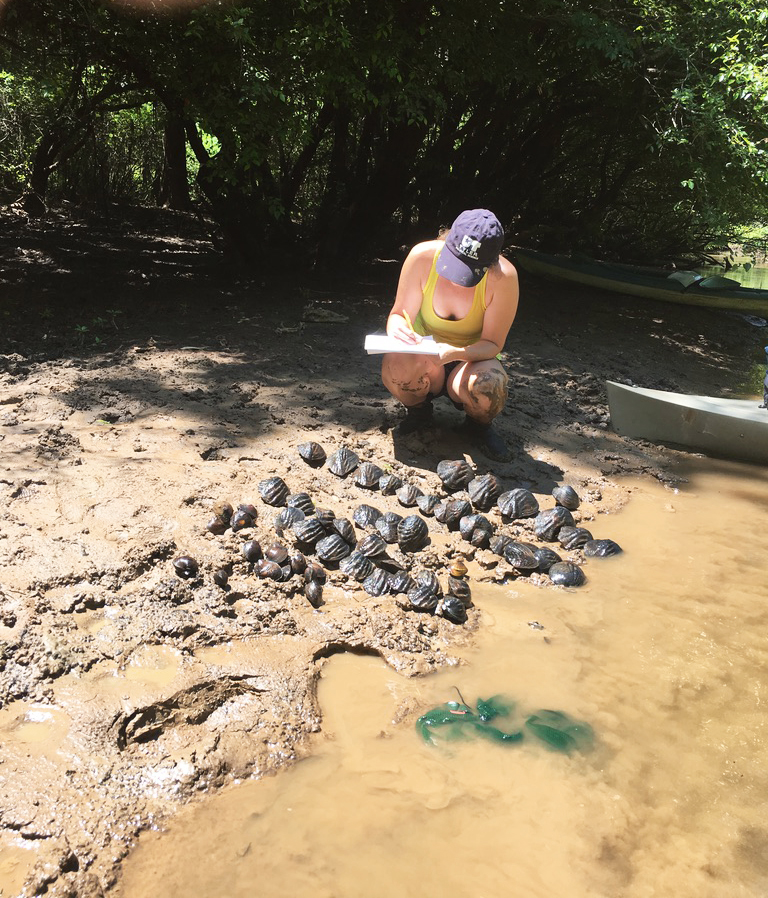
For us humans, if the temperature goes up or down ten degrees, we might worry about whether to grab a jacket or leave it at home. Researchers at the University of Texas at Tyler have found that for freshwater mussels, a ten-degree shift can mean the difference between survival and mass extinction. If our local rivers and lakes get warmer—as is predicted to happen as the climate heats up—it probably spells doom for the dozens of freshwater mussel species that call East Texas home.
You might be thinking, freshwater mussels? In East Texas? Why should I care if they boil or freeze? Scientists at U.T. Tyler’s Center for Environment, Biodiversity, and Conservation say these little shelled creatures play a surprisingly huge role in keeping our local water supply clean and drinkable.
“Imagine a world where the streams and rivers are so cloudy, you cannot see an inch below the surface, only the most tolerant fish species survive, and the mouths of rivers are choked with sediment,” says Danielle Joerger, a biology graduate student at U.T. Tyler who assisted this research. “This would be a world without freshwater mussels.”
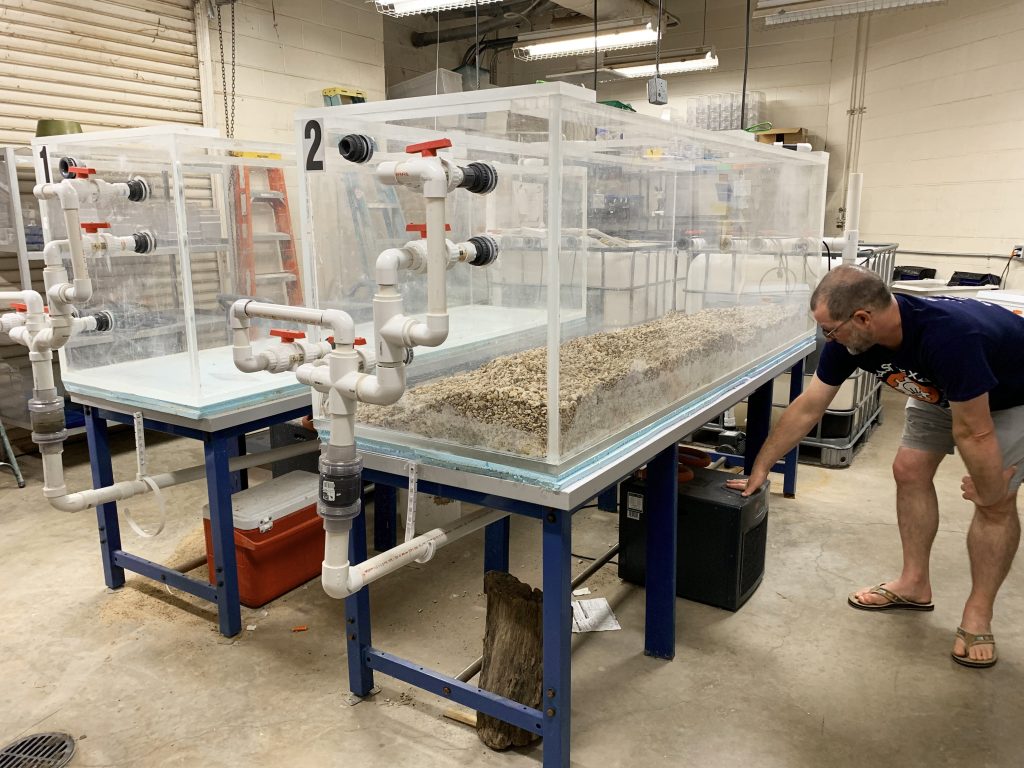
The U.T. team recently conducted a “sacrificial” experiment involving dozens of Texas Pigtoes, a threatened East Texas mussel species. The mussels were first acclimated in a tank kept at 68° Fahrenheit, the average temperature of Texas rivers over the course of a year. Then, some were moved into a tank kept at 86°, the highest temperature on record for the Neches River, the longest natural river in East Texas and home to nearly three dozen mussel species. Three weeks later, 14 percent of the tank-bound mussels were dead. At 96°, they all died.
This isn’t some hypothetical scenario or far-off dystopia. According to the U.T. researchers, climate change will make record-high temperatures more common in East Texas rivers over the next 30 years. It will also bring increased rainfall and water acidity, and both are bad for mussels. “Spoiler alert: They’re not making it,” says U.T. Tyler undergraduate researcher Kinza Ashraf. “The way that the climate’s changing, they have a slim to no chance.”
“When I see the results for that one species, that’s enough for me to set off the warning bells,’” says Dr. Lance Williams, who chairs the biology department at U.T. Tyler. “I think we as scientists are often overly cautionary, but at the same time, as a citizen, I step back and look at my research and I’m just terrified.” He adds, “This is a problem that we as a society are going to have to solve.”

“The liver of our rivers”
Biologists are fond of describing mussels as “the liver of our rivers.” Just as human livers filter toxins from our bloodstreams, mussels filter toxins from actual streams. They clean our freshwater of pollutants, bacteria, and toxins like heavy metals, keeping them safely stored in their shells for up to a decade after they’ve died.
One mussel can filter a liter of water—the size of a large water bottle—in just thirty minutes. Most mussels congregate in beds of thousands, naturally filtering the water that all local flora and fauna rely on—including us.
Or at least, that’s what they do in healthy waterways. Here in East Texas, and in large swaths across America, freshwater mussels are disappearing rapidly. “The public is just generally not aware of water quality issues that we have in East Texas, and they’re fairly significant,” says Williams.
Mussels are mighty cleaners, but, just like human livers, they can only take so much. Extremely sensitive to any type of change, they’re typically the first organisms to disappear when a marine environment changes. That’s why biologists often look to a waterway’s mussel population to check out how the ecosystem is faring. Happy, abundant mussel colonies indicate pure, unpolluted water. Sick or scarce mussels suggest that the water is dirty, with low essential mineral counts.
Williams is one member of a team of four lead researchers at U.T. Tyler who have made freshwater mussels the main focus of their research—where they live, how they reproduce, and how to save them. Each brings a particular superpower to the effort.
Williams has the most experience in endangered species management, with research expertise in aquatic ecology. Dr. Neil Ford, who founded the Center for Environment, Biodiversity, and Conservation on U.T. Tyler’s campus, handles most of the field work, spending a lot of time canoeing down the Sabine, Neches, and Angelina rivers and scanning their shorelines for empty mussel shells. Research Associate Marsha Williams is a hydrologist who works with geographic information systems —think Google Maps for conservation biologists. (Lance and Marsha are married.)
Lastly, there’s Dr. Josh Banta, the team’s geneticist and computational analyst. Banta dubbed the research team the “unicorn hunters,” because their current mission is a search for the rarest of all East Texas mussels: the Texas Heelsplitter.
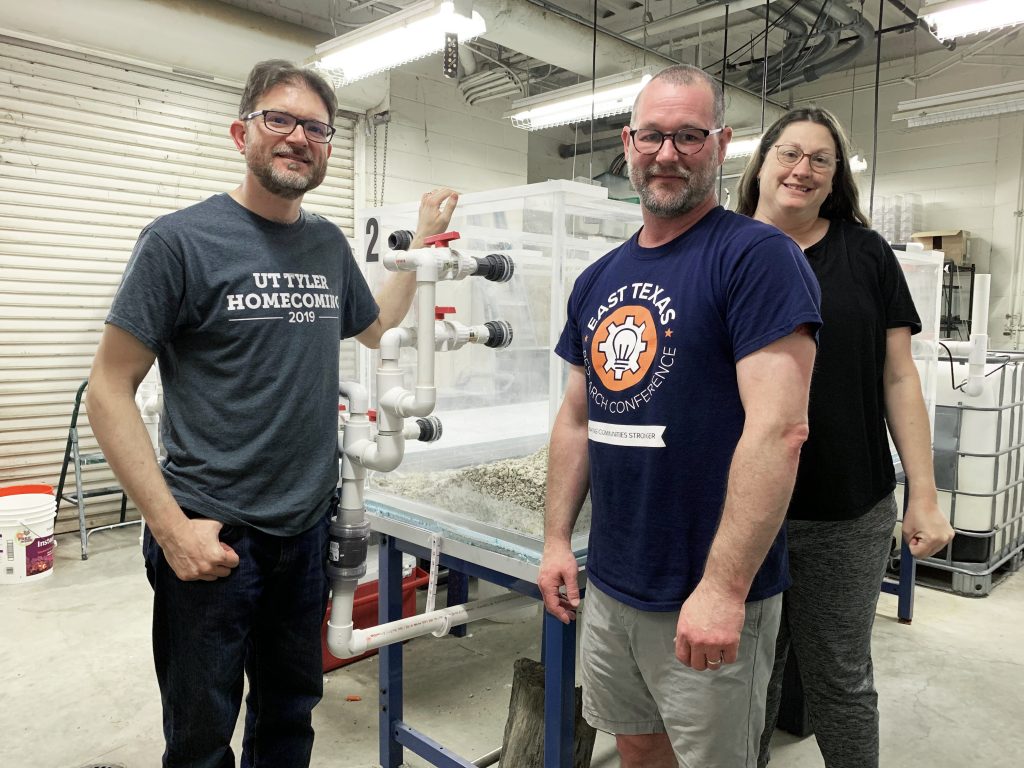
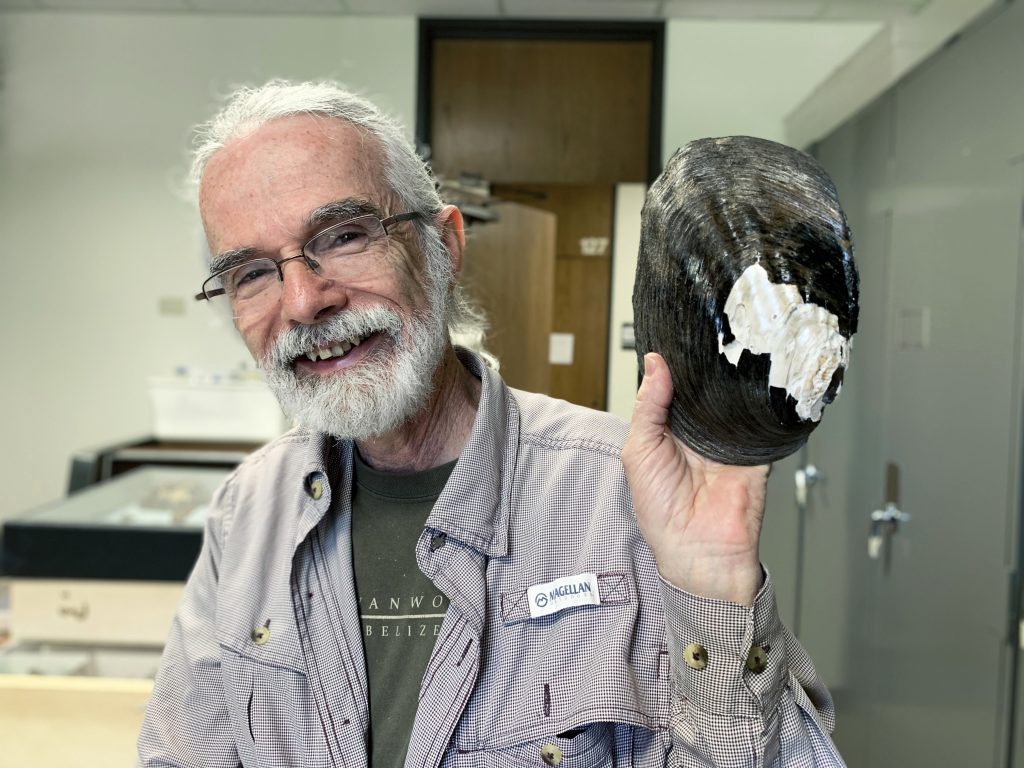
Texas has roughly 50 species of freshwater mussels, 37 of which make their home in East Texas. Fifteen species have been put on the state’s endangered species list and six are under consideration. Two of the endangered species live in East Texas, and the Heelsplitter is the most threatened.
The U.T. unicorn hunters have been searching for the Heelsplitter for 14 years. Simply identifying it is hard enough. Most mussels are identified based on their shape, weight, and the pearlescence inside their shells. The Heelsplitter, with its oblong, flaky, paper-thin shell and prismatic pink interior, looks remarkably like its cousin, the far-less endangered Pink Papershell mussel. So far, the U.T. Tyler team has found the most specimens in the world, though it’s hardly a haul. Out of 34,000 live mussel specimens they’ve collected, 40 have been Texas Heelsplitters.
“You may think, ‘Why focus on this one species when it’s just one species?’” says Banta. “By preserving the habitat of one species, you’re preserving entire ecosystems where everything’s all connected.”
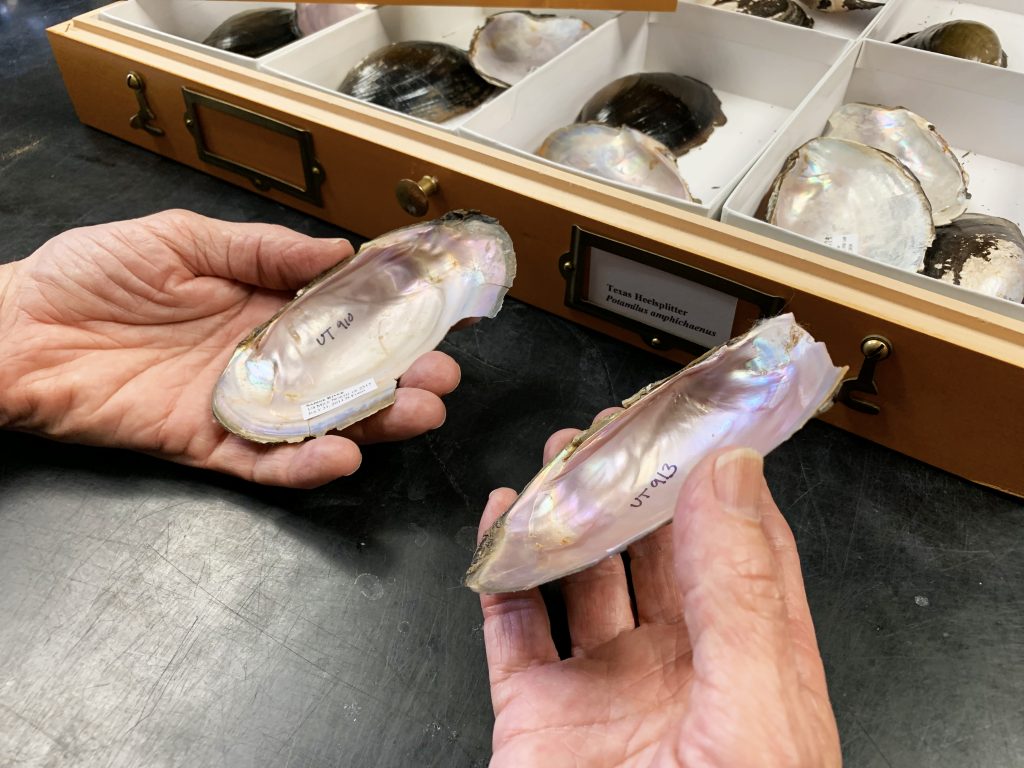
It’s already likely that no freshwater mussels exist in the creeks and rivers within Tyler city limits today, according to the U.T. Tyler team. Whitehouse Dam at Lake Tyler is one big reason for that. Mussels are sessile, meaning they don’t move to catch their food; they let the river’s natural current drift their food right to them. Damming a river interrupts its natural flow. It also cuts mussels off from the fish species on which they lay their larvae, making it harder to reproduce.
Then there’s pollution, like the three different raw sewage spills that have dumped into Tyler’s Black Fork Creek, which flows through Woldert Park in North Tyler, in the last two years. Each spill poured over 100,000 gallons of raw sewage into our water system. Black Fork Creek is a tributary of Lake Palestine, from which the city gets 40 percent of its drinking water.
As the heated-water-tank experiment suggested, it’s increasingly likely that many more East Texas mussels will disappear over time. “The results of climate change as we project it are going to be catastrophic to the organisms that live in our rivers,” says Williams.
You may have noticed how much rain Tyler is getting lately. Banta says that’s likely a symptom of climate change. With a warmer climate and evaporation, there’s more water in the atmosphere. Mussels use minerals in the water to build their shells, and increased rainfall dilutes many of the essential minerals in the rivers, making it difficult for mussels to hold their own structure. Rain, Banta says, is a huge consideration in how well these future populations will survive.
Between increased rainfall and the warming of East Texas’s rivers, several species are predicted to be critically endangered by 2050.
A “crisis discipline”
Researching mussels is hard and expensive work. The U.T. Tyler team has been studying local species since 2005, and they’ve only documented 35 specimens of East Texas’ 37 species. Of the six rare species in East Texas, the team only knows what type of fish two of them lay their larvae on. Figuring that out took three masters’ theses, six years, two grants, and a $12,000-dollar fish tank.
The research team says efforts are being made around the country to conserve endangered mussels by tearing down dams and funding more research. U.T. Tyler’s “unicorn hunters” have gotten over $1 million in funding for more conversation research from some surprising places: the Texas Department of Transportation, Texas Comptroller of Public Accounts, The Big Thicket Association, coal companies, and even the Department of Defense. They been able to collaborate with professors and faculty from U.T. Tyler’s computer science, business, civil engineering, and social sciences departments on some of these efforts.
But many times, funding comes too late to help save a species. Conservation biologists call their field a “crisis discipline.” They’re usually called in only after humans have done extreme damage to the environment or a species. “If we wouldn’t have had all those sewage spills, we probably wouldn’t have the project that we do in the upper Neches River,” says Lance Williams.
“If you’re talking about a human, doctors don’t want to wait until the person has advanced diabetes and cancer before they’re called in to see the patient and treat the patient,” says Banta. “By focusing all of our funding on species only when things get to a crisis point, that’s the equivalent of sending the doctor to treat a patient with raging cancer and diabetes. At that point, it’s a lot harder.”
Conservation biologists can study how to best preserve critically endangered species like mussels and make recommendations, but they can’t do much more than that on their own. They have to persuade landowners, city officials, and policymakers to actually implement their hard-won ideas, whether it’s simply moving a mussel population downstream from a construction site to programming dams release water at certain times to help mussels and other aquatic creatures mate.
The scientists at U.T. Tyler’s Center for Environment, Biodiversity and Conservation say listening to conservation biologists can do much more than impact a single species, however. They say experts in their field can help improve the quality of an entire region’s water supply. It’s been very frustrating for the team to watch serious water safety issues compound in Tyler over the last few years, from the Black Fork Creek sewage spills to boil water notices, EPA fines, and offline water treatment plants. “We have the expertise in the room to help solve some of these problems,” says Lance Williams. “The problem is—”
“No one asks us,” says Marsha Willams.
Maybe that will change. In April, U.T. biology grad student Danielle Joerger participated in a campus competition in which student researchers were tasked with explaining why their work matters to non-scientists. The judges were local community leaders with no expertise in the fields represented by the researchers. Joerger shared side-by-side photos showing how poorly mussels are able to filter water when their environment changes for the worse, and won third place.
And earlier this month, Lance Williams sat on a panel at the first-ever East Texas Research Conference, a two-day event hosted by U.T. Tyler as a way of highlighting the ways local universities can impact the wider region. The purpose of this panel was to ask how East Texas experts from widely different disciplines could do a better job of working together. It puts Williams side-by-wide with former Tyler mayor Barbara Bass, TISD assistant superintendent Christy Hanson, attorney and City Council candidate Nick Pesina, and others. Williams talked not only about his team’s mussel research, but about the larger infrastructure problems and water issues Tyler is facing from a biologist’s perspective.
Are events like these signs that the gap between East Texas’s scholars and the rest of us can be bridged to tackle some of our region’s biggest problems? “I’m hopeful,” says Williams.
In the meantime, what can someone who isn’t a full-time biologist do to help save our ecosystem? “Be a good community member,” says Dr. Banta. “Be a good citizen of your state and your country. Do that by participating in democracy. Ask questions of your leaders, be informed so you can ask informed questions, and run for office yourself. Put yourself in positions to affect the change that you want to see.”
Love what you're seeing in our posts? Help power our local, nonprofit journalism platform — from in-depth reads, to freelance training, to COVID Stories videos, to intimate portraits of East Texans through storytelling.
Our readers have told us they want to better understand this place we all call home, from Tyler's north-south divide to our city's changing demographics. What systemic issues need attention? What are are greatest concerns and hopes? What matters most to Tylerites and East Texans?
Help us create more informed, more connected, more engaged Tyler. Help us continue providing no paywall, free access posts. Become a member today. Your $15/month contribution drives our work.







